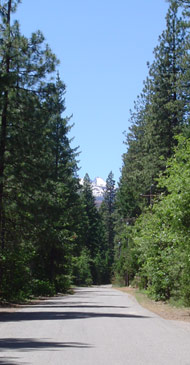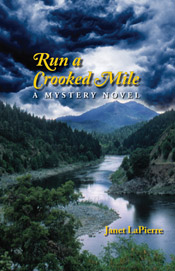Irish proverb: The most beautiful music of all is the music of what happens.
North State
Almost as soon as our two daughters were grown up and gone—first to college, then to their own independent lives—my husband and I bought a trailer, the kind called a fifth-wheel. As required by the city of Berkeley, we tucked it away out of sight in a trailer storage lot; but whenever time was available, we loaded up "the rig," ushered the dog into the back seat of the truck, and set off. We drove across the country, stopping at points of interest along the way, and visited relatives in Tennessee, and later in upstate New York. We went into the Canadian Maritime Provinces, to see Nova Scotia and Prince Edward Island. (I don't recall, pace Annie Proulx, that we went as far as Newfoundland.)
We took ourselves to Arizona; relatives again. We camped on the Oregon Coast, on the Olympic Peninsula, in the Idaho Panhandle, some of these places more than once. And we explored sites in northern California, mainly the north coast. In fact, after I began writing my Port Silva mysteries, set in a mostly-fictitious town on the Mendocino Coast, we spent a lot of time in that area and came to be very fond of it. Truth to tell, towns there are quite a lot like Berkeley, just smaller and less noisy.
 Over time, we did a bit of exploring in inland Northern California. We camped several times in a park in Plumas County, and I set part of a mystery novel, Old Enemies, in Modoc County, which occupies the state's north-eastern corner. Then one day, something—I think it was a piece in a magazine—sent us off to a new place, Trinity County, and it was love at first sight. Ever since, we've been going there most summers for a week or two at a time: a long slog up Interstate 5, to be smitten anew each time by the sight of Mount Shasta before turning left onto the swooping, two-lane, don't-look-down road to Trinity.
Over time, we did a bit of exploring in inland Northern California. We camped several times in a park in Plumas County, and I set part of a mystery novel, Old Enemies, in Modoc County, which occupies the state's north-eastern corner. Then one day, something—I think it was a piece in a magazine—sent us off to a new place, Trinity County, and it was love at first sight. Ever since, we've been going there most summers for a week or two at a time: a long slog up Interstate 5, to be smitten anew each time by the sight of Mount Shasta before turning left onto the swooping, two-lane, don't-look-down road to Trinity.
Trinity is a large, odd-shaped county occupied mostly by trees, mountains, lakes, rivers, and very few people; the piece we're most familiar with is the northern section, along the Trinity River. Our favorite campground is set in second-growth, or maybe third growth, forest of mostly Jeffrey and Ponderosa pines, Douglas firs, and Port Orford cedars, with the occasional live oak or big-leaf maple thrown in. My ancient "Pacific Coast Tree Finder" calls this a mixed-conifer forest. When I walk through the big campground and look around, my eye-level gaze meets many straight, beautifully grooved trunks; an upward glance shows the green crowns that filter the hot sun, and the mountains all around. At night I can see stars instead of street-lights; and there is no freeway noise, only the sound of an occasional single vehicle.
The big Trinity Lake, nearby, is beloved of our labrador retriever, Dulcie, as a swimmng hole; and of many fisher-folk, locals and visitors, for its bass population. In the spring, a creek across the road from the campground makes raucous music in its stony bed, sometimes reminding me of the roar of surf. When we've had enough solitude and scenery, we drive to the small towns.
The county seat, Weaverville, has an official population of about 3,200. It's an old mining town; nearby sections of the Trinity River flow through huge piles of rocks, mine tailings left from dredging operations. It's an attractive town, too, with a Main Street Historic district, some handsome brick buildings dating from the late 1850's, and a number of wooden houses from the 1870's and '80's, many of them well-maintained rather than remodeled.
What Weaverville is not, however, is cute or trendy, nor purposefully touristy in appearance. It has a new brick library, for which I'm told the locals formed a chain to hand-pass books from the old building down the block to the new one. One of the old Main Street wooden buildings now houses the quite modern Highlands Art Center, where works of local and regional artists are displayed. The logging industry is not what it was, but there's still a big lumber mill in Weaverville, with arcs of water spraying over huge piles of logs.
For outlanders like us, the summer travels to Trinity are made with both excitement and a touch of trepidation. People across the country know about our earthquakes, but another grim fact about California is this: it burns. And Trinity, with its isolation and extensive forests, is a fire-vulnerable place. Every year, when we come up from the Bay Area, we note a section that is newly blackened, or one that has slowly become green again after a years-ago fire. Residents and visitors are already alert on our early-June trips, with strict no-burn rules posted and being enforced; a fire in any but explicitly permitted places quickly brings a forest service plane overhead, green fire-control trucks to the gate.
September, however, is the real burn season, and in 2008 many places in California had already burned, most notably Big Sur, on the central coast—and the north counties, Shasta and Siskiyou and, indeed, Trinity. In Berkeley, we watched the newspaper and television reports, checked the internet. By the end of August, the major Trinity fires were pronounced contained, and we decided to head out.
In Weaverville we found that locals were pursuing their lives in normal fashion. Proprietors of restaurants with outdoor eating area dusted ash off their tables and chairs each morning. The "First Saturday" art event went on as planned, with artists, wine and hors d'oeuvres available in stores and galleries. One evening we drove into Weaverville for dinner, and found the town's best restaurant closed, serving only firefighters. Smoke had been pretty nasty this year, people agreed; but the air was better now. Radio service is limited there, mostly to NPR, but nearly everyone has a scanner, watches for any emergency information, and passes it on. This is a place where people living on the other side of the lake either arrange for their own electricity—hydro, solar—or manage without.
To a visitor from the city, it's not only the trees and mountains that make this a different place. In the contemporary American world, people in distant, isolated places like this are there because they have chosen to lead their lives in a whole different way, with different rules and patterns. There are a few second-homes developments in the area, but few of the houses fall into McMansion class. When the fires burned, many people who owned ranches or stands of timber chose to stay and fight along with the Forest Service people. And once the fires were mostly out, the local newspaper was full of vigorous discussion of firefighting techniques and how they needed to be changed.
I'm fairly sure I couldn't live this way; but I can admire, and sometimes envy, those who do.
—Janet LaPierre
Return to the current Music of What Happens
© Janet LaPierre.
